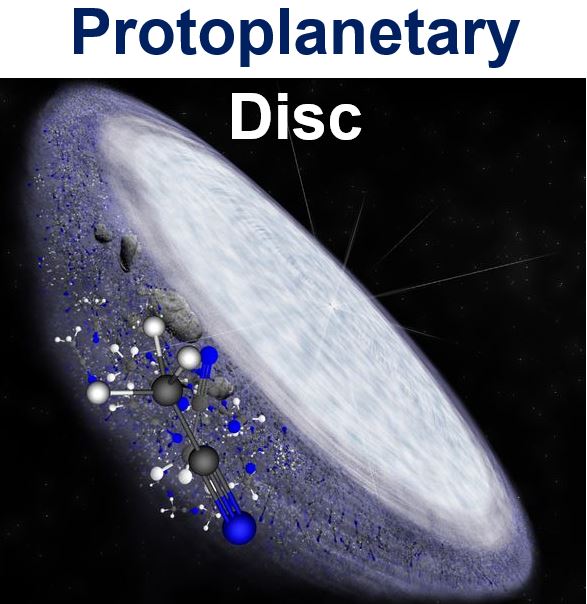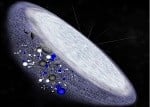Complex organic molecules vital for the eventual creation of living organisms have been detected in a young star’s protoplanetary disk, just like the ones found on comets of our own solar system, scientists from the Harvard-Smithsonian Center for Astrophysics announced this week.
Their findings, which have been published in the academic journal Nature (citation below), show that the same chemical building blocks that lead to the existence of life as we know it may be common in distant star systems.
Recent observations by the state-of-the-art telescope – Atacama Large Millimeter/submillimeter Array (ALMA) – showed that the protoplanetary disc surrounding MWC 480, a one-million-year-old star, contains large amounts of CH3CN (methyl cyanide), a complex carbon-based molecule. MWC 480 is an infant in comparison to our Sun, which is over four billion years old.

The protoplanetary disk is a rotating disk of dense gas that surrounds a young star. Planets may eventual form, or be in the process of forming, from this dense gas.
Plenty of methyl cyanide
There is enough CH3CN in MWC 480’s protoplanetary disc to fill all the oceans on Earth, the authors wrote.
Both methyl cyanide and HCN (hydrogen cyanide), its simpler cousin, were detected in the cold outer reaches of the star’s newly-formed disk. This region, according to astronomers, is the equivalent to our solar system’s Kuiper Belt, a region beyond the planets, the realm of planetesimals (objects formed from dust, rock, and other materials) and comets.
Comets retain a perfect record of the Solar System’s early chemistry, dating back to when planets were being formed. Scientists believe that asteroids and comets from the outer Solar System seeded the young Earth with organic molecules and water, helping set the stage for the emergence of primordial life.
Lead author, Karin Öberg, an astronomer with the Harvard-Smithsonian Center for Astrophysics in Cambridge, Massachusetts, USA, said:
“Studies of comets and asteroids show that the solar nebula that spawned the Sun and planets was rich in water and complex organic compounds.”
“We now have even better evidence that this same chemistry exists elsewhere in the Universe, in regions that could form solar systems not unlike our own.”
Similar concentrations to our Solar System’s
The scientists were intrigued to find that the molecules found in MWC 480 appeared in similar concentrations to those recorded from our Solar System’s comets.
MWC 480 is about twice the mass of our Sun and is located 455 light-years from our Solar System in the Taurus star-forming region.
The young star’s surrounding disc is in the very early stages of development – having recently merged from a cold, dark nebula of gas and dust.
Studies with ALMA and some other telescopes have not yet detected any clear signs of planet formation within the disk. However, higher resolution observations might reveal structures similar to HL Tauri, which is about the same age.
Cyanides vital for the creation of life as we know it
Scientists have known that cold, dark, interstellar clouds are excellent factories for complex organic molecules – including cyanides. Cyanides, and most especially methyl cyanide, are key to the formation of living organisms. They contain carbon-nitrogen bonds, which are vital for the formation of amino acids, the foundation of proteins.
Until this latest study, nobody knew for certain whether these same complex organic molecules could survive in the energetic environment of a newly-forming solar system, where radiation and shocks can easily break chemical bonds.
According to ALMA’s observations, these molecules do not only survive, they also flourish.
The scientists were surprised to find that these molecules are much more abundant than would be found in interstellar clouds, suggesting that protoplanetary discs are excellent environments for the formation of organic molecules and that they are able to form them in relatively short timescales.
As the system evolves, Öberg and colleagues speculate that the organic molecules safely locked away in comets and other icy bodies will probably be transported to environments more nurturing to life.
Öberg concluded:
“From the study of exoplanets, we know the Solar System isn’t unique in its number of planets or abundance of water. Now we know we’re not unique in organic chemistry. Once more, we have learnt that we’re not special. From a life in the Universe point of view, this is great news.”
Citation: “Planetary science: Prebiotic chemistry on the rocks,” Geoffrey A. Blake & Edwin A. Bergin. Nature. Published 8 April 2015. DOI: 10.1038/520161a.

